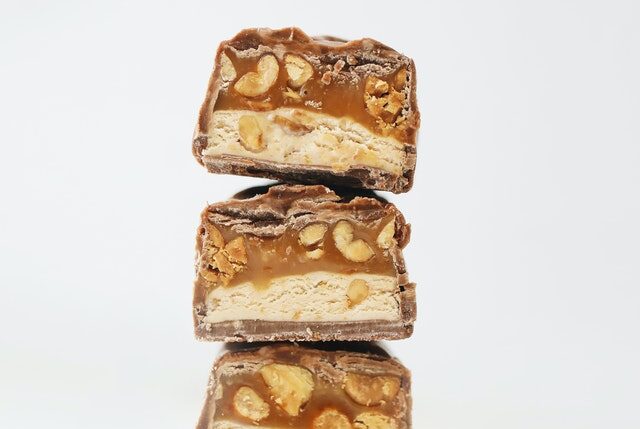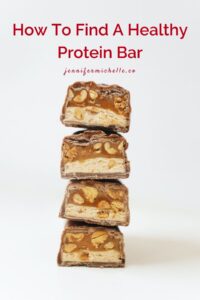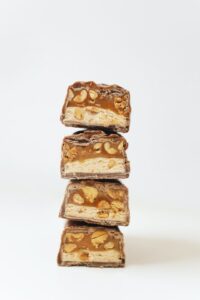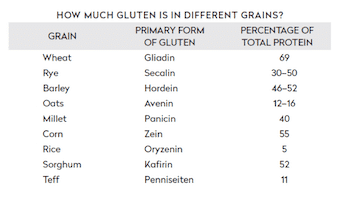I earn a small commission via affilate links at no extra cost to you.
The other day a friend asked me about portable low-carb snacks that offer a reasonable amount of protein. When I stood in the snack bar aisle at Target yesterday it reminded me that I need to write this post. For an average person who doesn’t know what they’re looking for it’s easy to get lost in the marketing labels on the front of the box. Most bars these days say they’re a protein bar but when you read the ingredients many of these bars are better left on the shelf, especially if you’re looking for a low-carb healthy snack. In order to help you decipher what a healthy protein bar looks like I’ve chosen ingredients from 4 random bars. Below I list the ingredients, macros, and package claims, that is – what does the package say on the front. So often people use the package front to select what they believe is the healthiest protein bar, but I’m going to show you that you really have to look at the protein bar ingredients if you want to get the best protein bar.
Examples of “Healthy” Protein Bar Ingredients
Protein Blend (Whey Crisps [Whey Protein Concentrate, Corn Starch, Calcium Carbonate], Milk Protein Concentrate, Calcium Sodium Caseinate, Whey Protein Concentrate, Whey Protein Isolate, Dried Egg White, L-Glutamine), Corn Syrup, Brown Rice Syrup, Milk Chocolate Drops (Sugar, Whole Milk Powder, Chocolate Liquor, Cocoa Butter, Milk Fat, Soy Lecithin, Natural Vanilla Flavor), Glycerin, Natural Flavors, Crystalline Fructose, Maltodextrin, Canola Oil, Water, Potassium Chloride, Vitamin and Mineral Blend (Ascorbic Acid, Tricalcium Phosphate, D-Alpha Tocopheryl Acetate, Niacinamide, Zinc Oxide, Copper Gluconate, D-Calcium Pantothenate, Vitamin A Palmitate, Pyridoxine Hydrochloride, Thiamin Mononitrate, Riboflavin, Folic Acid, Biotin, Potassium Iodide, Cyanocobalamin), Peanut Flour, Almond Butter, Soy Lecithin.
Macros: 12g Fat; 45g Carbohydrate; 30g Protein
Package Claims: 25% Less Sugar; 30g Protein; Meal Replacement Bar; 18 Vitamins & Minerals
Protein Blend (Milk Protein Isolate, Whey Protein Isolate), Isomalto-Oligosaccharides (Vegetable Source), Maltitol, Vegetable Oil Blend (Palm Kernel Oil, Palm Oil), Vegetable Glycerin, Polydextrose, Sunflower Seed Butter, Natural Flavors, Soy Lecithin (an Emulsifier), Whey Protein Concentrate, Corn Starch, Sea Salt, Nonfat Dry Milk, Tapioca Starch, Sunflower Oil, Distilled Monoglycerides, Sugar, Sucralose, Calcium Carbonate, Fruit and Vegetable Concentrates (for Color), Dextrin, Spirulina Extract (for Color), Confectioner’s Glaze, Annatto Extract (for Color), Turmeric Extract (for Color), Carnuba Wax and Sodium Bicarbonate.
Macros: 8g Fat, 23g Carbohydrates; 20g Protein
Package Claims: 20g Protein; 1g Sugar; Gluten-Free
ORGANIC PROTEIN BLEND [ORGANIC BROWN RICE PROTEIN, ORGANIC PROTEIN CRISPS (ORGANIC PEA PROTEIN, ORGANIC RICE FLOUR), ORGANIC GROUND CHIA SEEDS], ORGANIC TAPIOCA SYRUP, ORGANIC TAPIOCA FIBER, ORGANIC ALMONDS, ORGANIC CHOCOLATE CHUNKS (ORGANIC CANE SUGAR, ORGANIC COCOA LIQUOR, ORGANIC COCOA BUTTER, ORGANIC VANILLA EXTRACT), ORGANIC ERYTHRITOL, ORGANIC VEGETABLE GLYCERIN, NATURAL FLAVORS, SEA SALT, SUNFLOWER LECITHIN.
Macros: 5g Fat; 19g Carbohydrates; 10g Protein
Package Claims: Non-GMO; Soy Free; Vegan; 3g Organic Fiber; 10G Plant Based Protein; Gluten-Free
Chocolate Flavored Coating (Maltitol, Fractionated Palm Kernel Oil, Whey Protein Concentrate, Cocoa [processed with alkali], Calcium Carbonate, Natural Flavors, Soy Lecithin, Sucralose), Hydrolyzed Collagen, Peanut Flour, Protein Blend (Milk Protein Isolate, Whey Protein Isolate, Whey Protein Concentrate), Glycerin, Maltitol Syrup, Soy Crisps (Soy Protein Isolate, Tapioca Starch, Salt), Water, Peanuts, Peanut Oil, Sucrose, Salt, Natural Flavors, Sucralose, Almond Butter, Soy Lecithin.
Macros: 6g Fat; 16g Carbohydrates; 20g Protein
Package Claims: 20g Protein; 2g Sugar; 200 Calories; Gluten-Free
What’s Wrong With Some Protein Bar Ingredients?
The first thing I look at before I buy any food is the ingredients and the general rule of thumb is the fewer ingredients the better. Let’s use the second bar as an example. On the front of the package they boast 20g of protein and 1g of sugar, and it also says it’s gluten-free. First, let’s start off with why I’d avoid this if I were truly trying to eat gluten-free. The bar contains dairy and the casein protein in dairy affects the lining of the small intestine the same way that gluten does through molecular mimicry. While dairy isn’t gluten it’s still something I would avoid if I had gut health issues or issues with inflammation. Anytime you see Whey that product contains dairy. While most bodybuilders love whey protein there is a difference between whey protein isolate and whey protein concentrate. If you want less dairy opt for the isolate.
Gluten Free Protein Bars?
Gluten is a lectin and all grains and legumes contain lectins. Nuts and seeds contain lectins to a lesser extent, and so do some fruits and vegetables. If you want to know more about lectins read this post. If you have gut health issues and you’re avoiding gluten I’d err on the side of caution and either limit or remove lectins from your diet too. The ingredients listed above with corn, rice, peanuts, sunflower, pea, almonds, soy, and cocoa also have lectins.
Sweeteners In Protein Bars
Most protein bars claim only a few grams of sugar on the front of the package because they use a variety of alternative sweeteners. The discrepancy is that what you eat and what your body does with it are two very different things. Malitol is an example of a sugar alcohol. Any ingredient ending in -ol is likely a sugar alcohol. Ingredients are listed in order of abundance so bars that list sugar alcohols pretty soon in the ingredient list have quite a bit meaning there’s quite a bit. How do sugar alcohols differ from sugar? Sugar alcohols have characteristics of both sugar and alcohol but technically they are neither. They don’t contain alcohol and they don’t affect blood sugar the same way that real sugar does.
Why might sugar alcohol be bad for you? Some people will experience sugar alcohol side effects like diarrhea and gas, especially if they consume too much. In excess, they can have laxative effects, which means limiting your intake is a good idea.
The problem with sugar alcohols is that they can create digestive distress, as in green apple quick step, must find a loo before I shat my pants digestive distress. Some people experience side effects like gas and diarrhea if they consume too many. Eating sugar alcohols on an empty stomach versus between meals will also change how they affect you. Too many sugar alcohols have a laxative effect which is why limiting your intake is a good idea.
Other Sugars/Sweeteners Added To Protein Bar Ingredients
Then there are ingredients like polydextrose, maltodextrin, and sucralose which are all added sugars. The problem with any alternative sweetener is that your body releases insulin the moment something sweet touches your tongue. Insulin is released, sugar never arrives, blood sugar drops, and then it activates hunger signals and the body’s fight or flight response. When the sympathetic, fight or flight, portion of the nervous system is activated, cortisol is released which in turn causes the body to release glucose into the blood. Science has shown that artificial sweeteners like sucralose predispose someone to develop type 2 diabetes. [1][2] Also, if you find yourself hungry after eating one of these bars, and you feel like you need another that’s why. It sells more products.
Ingestion of these artificial sweeteners (AS) results in the release of insulin from pancreas which is mistaken for glucose (due to their sweet taste). This increases the levels of insulin in blood eventually leading to decreased receptor activity due to insulin resistance.
Effect of artificial sweeteners on insulin resistance among type-2 diabetes mellitus patients
Determining Whether It’s A Low Carb Snack
You may be wondering how do these bars get away with stating few carbs on the front of the package when the nutrition facts say something else. Many products list the added sugars on the front and don’t mention the rest. To be fair there is a difference between total carbohydrates and net carbohydrates. When calculating net carbohydrates you take the total carbohydrates and subtract dietary fiber to get net carbohydrates. Looking for a low carb snack or food item some people prefer total carbohydrates whereas others go by net carbohydrates. In my book it’s really up to you. If you’re seeing the results you’re after then you do you. Just beware that many foods and low carb snacks are often loaded with various fibers in order to offset the total carbohydrate count.
How Vegetable Oil Sabotages Your Low Carb Snack
When it comes to the fats that are used palm oil isn’t the worst but it isn’t the best either. From an environmental and wildlife perspective you want to make sure that anything with palm oil is sustainably grown and harvested. The health issue lies in added vegetable oils classified as polyunsaturated fats. Sunflower, Canola, Soy, Corn, Vegetable, Peanut, and Safflower oils are a bigger concern. Polyunsaturated fats are a hard pass in my kitchen. They’re inflammatory, they hinder your body’s ability to burn body fat, they damage DNA, they promote cancer, and they can contribute to insulin resistance. Your healthy protein bar you carry for a low-carb snack might not add real sugar, but the other ingredients in the bar affect your body’s sugar metabolism.
Omega-6 polyunsaturated fatty acids (PUFAs), such as linoleic acid, as found in vegetable oils may contribute to obesity.
Good Fats versus Bad Fats: A Comparison of Fatty Acids in the Promotion of Insulin Resistance, Inflammation, and Obesity
Results confirm previous reports that omega-6 PUFAs are associated with hyperinsulinemia. Findings suggest omega-6 PUFAs are more likely markers of hyperinsulinemia.
Associations between omega-6 polyunsaturated fatty acids, hyperinsulinemia and incident diabetes by race/ethnicity: The Multi-Ethnic Study of Atherosclerosis
The Protein Bars I Buy For A Portable Low Carb Snack
Epic Bar Ingredients
Beef, Encapsulated Lactic Acid*, Onion Powder, Garlic Powder, Sea Salt, Black Pepper, Cultured Celery Powder.
*Not from milk
Lactic acid is an ingredient to be mindful of if you’re dairy sensitive because sometimes it’s sourced from dairy. I took the ingredients from the Epic website and you can see that their lactic acid is not from milk. Looking at the nutrition facts these bars contain 11 grams of protein, 3 grams of carbs, and 8 grams of fat. The fat is important because quality fat will fill you up. They also contain calcium and iron. Notice they didn’t have to add these nutrients, they already exist in the minimal ingredients listed above. The other thing I love about the Epic brand is that they are focused on animal welfare and they have their first bar produced to reduce carbon emissions.
We don’t really do snacks at our house. When you’re fat adapted you’ll find that you won’t typically feel hungry between meals. In the primal world most of us believe that your last meal failed you if you need a snack between meals. Even then, I’m also a mom to a pre-teen boy and I’d rather have something clean he can snack on. I hate that the snack/protein bar aisle is full of candy bars masquerading as healthy protein bars. Whenever I want to stock my kitchen with portable snacks I prefer meat based snacks, or snacks that have meat in them. Let’s just say I buy A LOT of Epic bars.
More Grass Fed Low Carb Snacks
I’ve tried Chomps before at the Paleo f(x) conference. Back then they didn’t offer a nightshade-free version, now they do. Their Italian and Sea Salt Beef flavors are both nightshade-free! When you have autoimmune joint issues like I do nightshades are your nemesis. Nightshades that are commonly found in meat snacks are spices like paprika and red pepper although there are others.
One stick of their Sea Salt Beef flavor has 6 grams of fat, 9 grams of protein, and zero carbohydrates.
Ingredients: Grass Fed & Finished Beef, Water, Sea Salt, Encapsulated Lactic Acid, Cultured Celery Powder (Celery Powder, Sea Salt), Garlic Powder, Stuffed In A Beef Collagen Casing
Chomps not only have real food ingredients, they also have a number of other health and environmental merits. Chomps protein snack sticks eliminate the guessing game when you’re looking for a low carb snack. Their snacks are made from sustainably sourced protein with no hidden or harmful ingredients.
- CLEAN AIP FRIENDLY SNACK – Ea 1.15oz meat stick has 9g protein, low sodium, low fat, low carb, sugar-free & 90 calories
- DIET APPROVED – Our jerky sticks are AIP Compliant, Keto, Whole30, Paleo, Non-GMO, Certified Gluten-Free
- ALLERGEN FRIENDLY – All natural, real ingredients that are dairy, soy & nut free, gluten & sugar-free, nightshade-free
- ON-THE-GO, QUALITY PROTEIN – Our beef is 100% Grass-Fed & Finished, Certified Humane, and nitrate & nitrite-free
Primal Kitchen Protein & Collagen Bars
Primal Kitchen has a pretty good variety of protein and collagen bars. Honestly, I like the collagen bars better. I’ve tried two of the protein bars and I didn’t like the taste. I mean, threw it away without finishing it, didn’t like the taste.
The Macadamia Sea Salt Collagen Bar is my Primal Kitchen go-to. I have a number of food sensitivities and chocolate is one of those things I try to avoid. The texture becomes dense as the bar gets cold, but it softens up a bit when it’s warmer. It’s just something to be mindful of if you were planning on taking them skiing and you have a lot of dental work.
Ingredients: Soluble Tapioca Fiber, Bovine Collagen Peptides, Almond Butter, Macadamia Nuts, Cashews, Organic Pumpkin Seeds, Egg Whites, Honey, Blanched Almond Meal, Water, Eggs, Natural Flavors (Contains Coconut), Sea Salt, Vanilla Extract, Sunflower Lecithin, Organic Rosemary Extract, Organic Monk Fruit Extract
I’m a fan of products that contain collagen not only for vanity purposes, but when you eat foods that support your hair, skin, and nails you also nourish the rest of your body. These bars contain 14 grams of protein and they tick the boxes of the healthy protein bar categories. They’re keto and paleo friendly and they’re grain-free.
They have 13 grams of fat, 7.5 grams of collagen, and they contain calcium, iron, and potassium. As for their carbohydrate breakdown: 14 grams of carbohydrates, 9 grams of dietary fiber, 3 grams of total sugars 2 grams of which are added. Notice that they also only list the added sugar on the front of the package. The sweeteners are monk fruit and honey. While I don’t typically like things with monk fruit I don’t notice the taste in these bars. They’re barely sweet at all. It’s more like they added just enough to make it taste good but they weren’t aiming for candy bar style sweetness. Dr. Paul Saladino is a carnivore doctor who advocates for honey as a sweetener. He wore a continuous glucose monitor and did some self-experiments with honey. He didn’t notice any significant changes in blood sugar after eating honey.
If you’re going to eat a sweetener I believe in eating one that humans have eaten for more than 100 years. Our paleolithic ancestors didn’t eat sweeteners made in a laboratory to maintain their health or physique. The difference is that they didn’t have a constant supply of sweeteners.
JenniferMichelle
Are RX Bars A Healthy Protein Bar?
RX Bars aren’t horrible. I admire the transparency by putting the ingredients clearly on the front of the package. They’re not a low-carb snack because the dates are little sugar bombs, but on the spectrum of sugar, at least whole dates have a bit of fiber to offset the sugar they contain. If you have a lot of food allergies, food sensitivities, or autoimmune issues I wouldn’t buy these because nuts and egg whites are highly allergenic. I think for a once in a while protein bar, the ingredients aren’t horrible if these ingredients work for you.
Finding The Healthiest Protein Bar
As you very well know there are countless protein bars on the market and I’ve only highlighted a few. If you want to reevaluate the protein bar you’ve been eating here are a list of things to check:
- What are the ingredients? Is it a simple list made of whole food ingredients?
- Are vegetable oils added?
- What are the total carbohydrates versus net carbohydrates?
- Do they contain lectins?
- How do these bars make you feel physically?
- Do they fill you up?
- Do you feel hungry after you’ve eaten one?
- Do they give you digestive upset?
- Do you enjoy eating them?
[1] https://pubmed.ncbi.nlm.nih.gov/33132722/
[2] https://www.medscape.com/viewarticle/885945
Originally posted on April 5, 2021 @ 16:03











